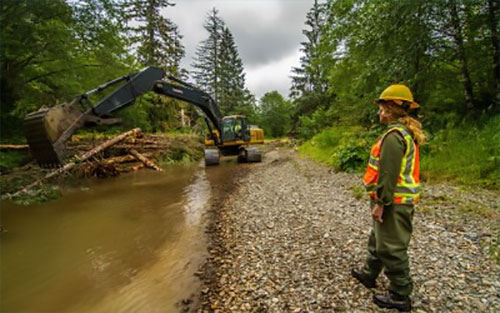|
Fish Factor Water changes in Southeast AK streams, fish protections outlined for first timeBy LAINE WELCH
June 27, 2018
One-third of Alaska’s salmon harvest each year comes from fish produced in the 17,000 miles of streams in Southeast’s Tongass rainforest. A changing climate is altering rain and snowfall patterns that affect that habitat – for better or worse. Now, a first of its kind study details the potential changes and how people can plan ahead to protect the fish.
Colin Shanley a conservation planner and GIS analyst for The Nature Conservancy in Juneau and co-author of “Climate Change Sensitivity Index for Pacific Salmon Habitat in Southeast Alaska" said, "In general the global climate models are saying it’s going to get warmer and wetter. I’ve also heard another rule of thumb that the wetter places in the world are going to get wetter and the dryer places are going to get dryer. Obviously Southeast Alaska is one of those wet places." Shanley studied nearly half a century’s records of water flows, temperatures and precipitations in-stream sources to model future projections. He said, "If we can build models based on historic patterns we can use these global climate models to sort of predict into the future how flows might change." Shanley says watersheds fed by snowpacks will likely experience the biggest impacts. "When we compiled data and models saw that some of the watersheds that are super steep and are fed by snow driven catchments are going to see some of the biggest changes. They might not all be bad but those are the ones that showed some of the largest changes in flow." On the other hand, glacial fed salmon systems could provide new and better systems. Shanley said, "In Southeast, South-central and Prince William Sound there’s a lot of glacial fed systems that salmon use and some glacier fed systems that salmon haven’t colonized yet. So there is some opportunity as glaciers shrink and melt that it would create new habitat and in some cases better habitat." "Some of the glacial fed systems here are really cold and so they have slower growing conditions and less food, but if some of those warm up they might actually become better salmon habitat," said Shanley. He continued, "And some of those glacial systems are really big rivers so there is definitely some opportunities for some sort of shift in productivity where some of the smaller streams might have a harder time but some of these glacial fed systems might actually uptake in their production." Watersheds that are in good shape should be fairly resilient. For waters near roads and other developments, The Nature Conservancy hopes to begin restorations – "We’ve started to look at the places we think high salmon values intersect with areas of potential restoration, evaluating where those failing culverts are to make sure that there is adequate draining, that there is no run off on these roads dumping excessive sediment in streams." Shanley said, "We’ve looked at areas where before more stringent timber management regulations required riparian buffers – is there adequate large trees along the rivers and if aren’t can we put some in there to build pools and provide shade as well as slow down the water in some of these high water events. So there are lots of things we can do." Who tops the list of worst fishing whiners? Alaska’s fisheries are targeted by many different gear types, from dip nets to big Bering Sea catcher processors. Fish Radio went down to the docks to hear what Kodiak fishermen believe are the whiniest group —
Representations of fact and opinions in comments posted below are solely those of the individual posters and do not represent the opinions of Sitnews.
SitNews ©2018 Stories In The News Ketchikan, Alaska
|
||||

